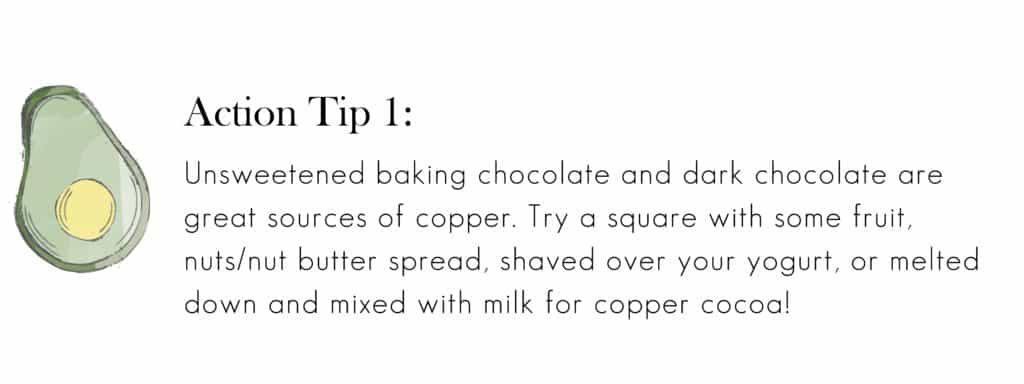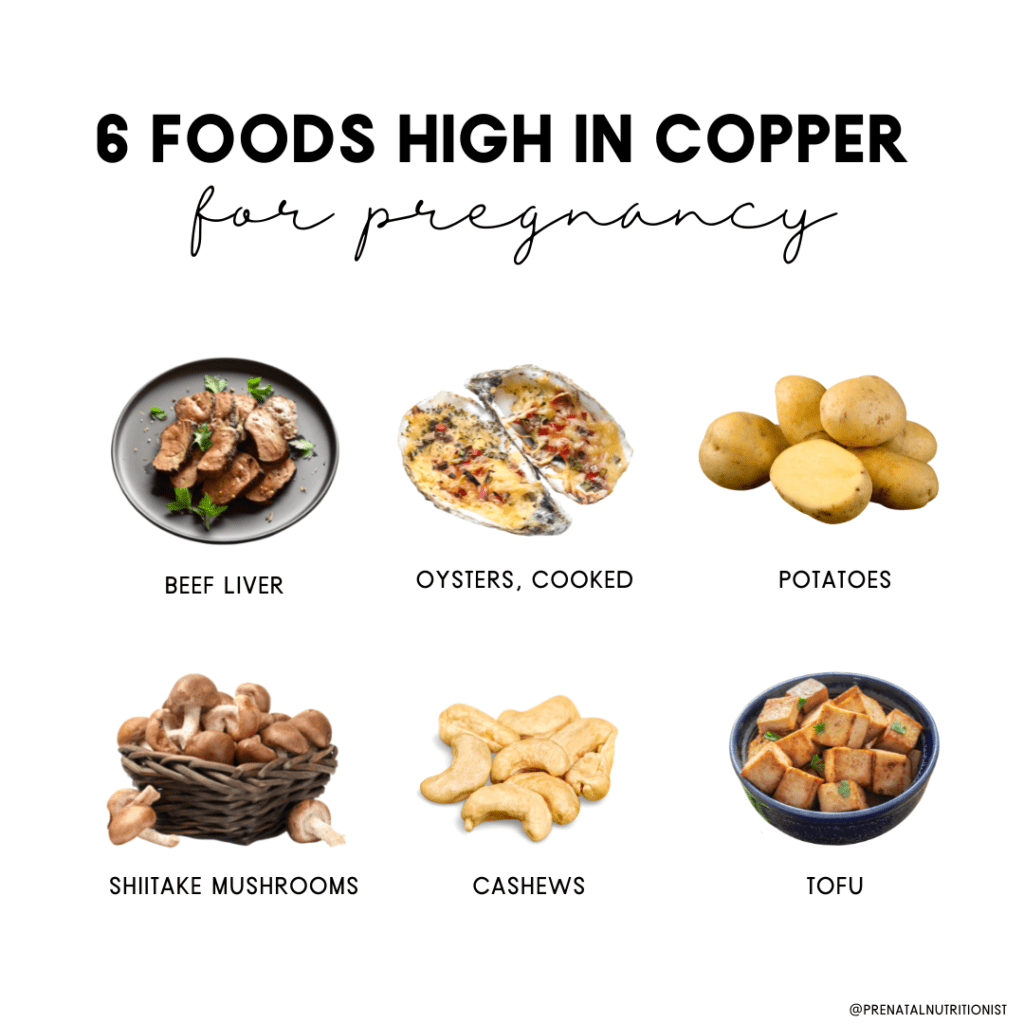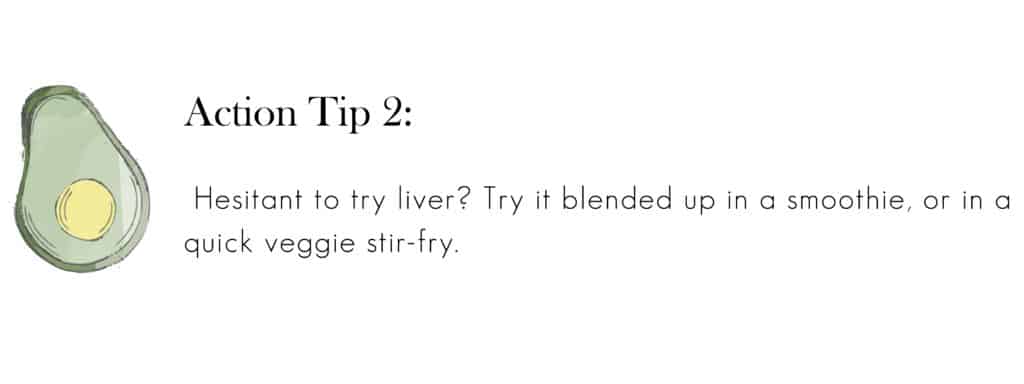When you think about copper, you might think of copper pans and pennies before you consider its role in the diet. What makes this mineral so important for pregnancy?
Let’s see what the research has to say about copper for pregnancy!
What is copper?
Copper is an essential mineral. That means it is one of 13 minerals that our bodies need for growth and development. Copper is involved in systems and processes all throughout our bodies, and has many roles in different organs (1).
Did you know copper is present in every single tissue in your body (1)? This means it’s abundant within a developing baby’s body as well. Let’s talk more about the many roles of copper and where we can find it in the diet.
What does copper do?
Copper is naturally present in some foods and is available as a dietary supplement, though one is not needed or recommended if you are eating a wide variety of foods containing copper.
Copper is involved in everything from gene expression and brain development to immunity, as well as iron absorption and use in the body (2). Copper increases the release of iron from where it is stored in the liver and spleen, which is an important function in preventing anemia (2).
Copper supports normal blood clotting processes and regulates our blood pressure (2). It also supports collagen production and is in our tissues all throughout our body (2). Copper helps prevent cell damage and helps us use the energy we get from food, and regulates our hormones (1).
Not getting enough copper can negatively impact cholesterol and glucose metabolism, blood pressure, cardiovascular system, bone health, and immunity (2).
As you can see, copper plays a role in every system in the body! But what is copper’s significance in pregnancy?
Why is copper important for pregnancy?
Copper plays a role in every organ system throughout the body! In pregnancy, copper can help with:
Trying to conceive
Though studies on the impact of copper on fertility at this time are limited, copper has been found to be in significantly lower concentrations among women with infertility when compared to fertile women (3). Copper concentrations have also been found to be slightly lower in women with secondary infertility problems (3). Maintaining an adequate intake of copper in your diet may help support your health when trying to conceive.
As we will discuss in a minute, it’s also important to maintain sufficient copper stores in the body before conceiving since it plays vital roles in early baby development!
Preventing anemia
During pregnancy, copper is especially important for helping prevent anemia. As we saw earlier, one of its roles is helping us absorb iron. During pregnancy, the body requires an increased amount of iron for creating hemoglobin, the red blood cell protein which transports oxygen to tissues and to your baby (4).
Higher iron demand and consumption means more copper is needed to meet these demands and help your body absorb and use iron effectively!
Growth and development
Getting enough copper in pregnancy is important to support new developing tissues in your body, as well as your baby’s body. It is also needed for supporting fetal growth and the lung, skin, bones, and immune systems (4), (5). Therefore, it’s important to make sure you’re getting enough copper in your diet to support early fetal development, which starts weeks even before you realize you’re pregnant!
Brain health
In the brain, copper plays a significant role in supporting normal development, especially in a growing baby, when the brain is being formed (6). Not getting enough copper can affect functioning and increase risk of neurological diseases (6).
Immune system support
Copper plays a critical role in maintaining a healthy immune system and in preventing infection (1). This is especially important in pregnancy, as your immune system is suppressed during this time.
Copper supports the functioning of your immune cells such as T helper cells, B cells, neutrophils, natural killer cells, and macrophages (7). These cells are all responsible for killing infectious microbes that enter your body.
Copper is also able to kill many infectious viruses, including bronchitis, polio, HIV, and many other DNA and RNA-related viruses (7). Copper deficiency is linked to having an increased vulnerability to infections, since it can lead to decreased numbers and reduced functioning of cells in the immune system (7).
An amazing antimicrobial
Copper is not only effective in killing many different disease-causing organisms inside our bodies, but also on the outside! Copper kills bacteria, fungi, and viruses, including MRSA and VRE, on surfaces (8). This means copper surfaces, like a copper faucet, can kill these and most other germs and viruses upon contact! (8)
Copper exposure is also correlated with improved wound healing, due to its capabilities to facilitate the formation of new blood vessels (9) .
*The possibilities of copper being used specifically in the field of obstetrics and gynecology due to these antimicrobial and wound-healing benefits (such as copper pads being used after childbirth delivery) are currently being studied, though further research is needed!* (9)
How much copper do I need?
The RDA for copper between ages 14-18 is 890 mcg and 1000 mcg if pregnant and breastfeeding. If you are over 19 years old, the RDA is 900 mcg, and it’s recommended you consume at least 1300 mcg if pregnant and/or breastfeeding (1).
Though there is an increased need for copper, taking a copper supplement is not recommended when pregnant. If you are concerned you may not be getting enough copper, it’s best to work on eating more foods that are high in copper instead.
Could I be deficient in copper?
Severe copper deficiencies are uncommon, but can occur in cases of malnutrition, or a lack of consumption of foods that are rich in copper (1).
Copper deficiency can also occur if excessive supplements of zinc and iron are taken (1). This is because copper is used to break down iron in the body and more is needed if more iron is taken, and zinc tends to be prioritized for absorption in the stomach before copper.
Most prenatal vitamins don’t contain a ton of zinc, so it is unlikely you are overdoing zinc by taking a prenatal vitamin alone.
Is copper important for postpartum and breastfeeding?
Copper has not been well-studied in relation to postpartum and breastfeeding. Still, given its role in preventing anemia and helping our bodies absorb iron, we can also assume its importance in preventing postpartum anemia (11).
Copper is also significant for immune support and is associated with improved wound healing and facilitation of new blood vessel formation, which are significant benefits to support your health and healing after giving birth (12, 13).
How much do I need?
The RDA for copper while breastfeeding is 1.3 mg/day, a little higher than the recommended amount during pregnancy.
Where can I find copper?
Some foods that are rich in copper sources include: shellfish, seeds and nuts, beans, dairy, organ meats, whole-grains, and chocolate (1) (yes, another reason to continue enjoying your dark or unsweetened chocolate during pregnancy!).
Sources of copper in your diet (from most to least) are (1):
- Beef liver
- Oysters
- Unsweetened baking chocolate
- Potatoes with skin
- Shiitake mushrooms
- Cashews
- Crab
- Toasted sunflower kernels (the inner “meat” of sunflower seeds)
- Turkey giblets
- Dark chocolate, dark
- Tofu
- Chickpeas
- Salmon
- Whole wheat pasta
- Avocado
- Dried figs
- Spinach
- Asparagus


 Can I get too much copper?
Can I get too much copper?
Copper toxicity is rare, especially if you’re healthy and living in a Western country, and when toxicity occurs, it is more commonly due to a contaminated water source (10).
However, chronic exposures to high levels of copper can result in liver damage and gastrointestinal symptoms (such as stomach pain, cramps, nausea, diarrhea, and vomiting) (10). Copper toxicity occurs very rarely in healthy individuals who do not have a hereditary copper homeostasis defect (10).
The recommended upper limit of consumption is 8,000 mcg for ages 14-18, and 10,000 mcg for ages 19 and older (1) .
Copper and gestational diabetes
Some recent studies have found significant associations between excessive copper and impaired glucose metabolism. However, the current evidence establishing a correlational relationship between high copper levels and gestational diabetes mellitus are too limited to draw any definitive conclusions at this time (11).
What about copper pans?
When using copper in the kitchen, it’s important to distinguish between the two types: uncoated copper vs. coated copper. Solid, uncoated copper pots are esteemed for their abilities to conduct heat more efficiently, which ensures even heat distribution when cooking.
Let’s talk about how this can be problematic:
- Uncoated: copper pots, cooking ware, drinking vessels, and storage containers can be dangerous because the copper molecules can seep into your food when cooking it, or when acidic foods break down copper and draw it into the food (10). This could lead to accidental over-ingestion of copper, which could cause copper toxicity.
- Coated: copper is lined inside with protective metals, including tin and stainless steel. The lining acts as a barrier to keep copper from seeping into your food. It’s important to note that the coating can become scratched or worn away over time with use, which means you will have to have them relined or replaced. To protect and maintain this barrier, use wooden spoons and spatulas to avoid scratching away at the coating.

The Bottom Line
- Copper is present in every organ system and tissue throughout the body, and is involved in functions including supporting heart health, immunity, promoting growth and development, brain health, and preventing anemia.
- Foods rich in copper include: shellfish, seeds and nuts, beans, dairy, organ meats, whole-grains, and unsweetened and dark chocolate.
- Copper pots and pans can cause copper toxicity if they are unlined, but are safe to use if coated with a protective surface inside. Use wooden spoons to avoid scratching off the coating, and replace copper pans once the barrier wears off.
Written by: Claire Gilmore, MSCN, CNS, LDN
Reviewed/edited by: Ryann Kipping, MPH, RDN, CLEC, Owner + Founder


